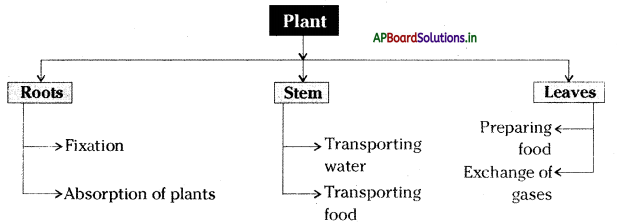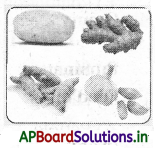Students can go through AP State Board 6th Class Science Notes Chapter 2 Knowing About Plants to understand and remember the concept easily.
AP State Board Syllabus 6th Class Science Notes Chapter 2 Knowing About Plants
→ The important parts of a plant are roots, stem and leaves.
→ The Taproot system and fibrous root system are two types of root systems seen in plants.
→ Dicot plants have tap root systems whereas Monocot plants have a fibrous root system. Roots help to fix the plant to the soil, absorbs water and minerals.
→ In some plant’s roots give additional support to the plants whereas fibrous roots, help to store the food.
→ The shoot system consists of stems, leaves, flowers, and fruits.
→ The stem transports water and minerals from roots to upper plant parts and food from leaves to other parts.
→ Potato, turmeric, garlic, ginger and sugarcane store food material in the stem.
→ Leaf base, petiole and lamina are parts of a leaf.
→ Reticulate and parallel venation are found in leaves.
→ The plants with taproot systems have leaves with reticulate venation and plants with fibrous roots have parallel venation.
→ Leaves are involved in preparing food. They also help in the exchange of gases and transpiration.
![]()
→ The flower has colourful parts to attract the insects for pollination.
→ We grow plants for colourful flowers which give beauty to nature.
→ Taproot: Large, central and dominant root from which other roots arise laterally.
→ Fibrous roots: A cluster of thin and uniform roots arising from the seed during germination.
→ Monocots: The plants which contain only one seed leaf within the seed.
→ Dicots: The plants which contain two seed leaves within the seed.
→ Node: Part of the stem, where the leaf and other parts arise.
→ Terminal bud: The bud is located at the tip of the stern.
→ Auxiliary bud: The bud or shoot at the axil of a leaf.
→ Leaf: a flattened structure of higher plants, typically green and blade-like structure.
→ Petiole: A stalk-like structure that joins a leaf to a stem.
→ Reticulate venation: The veins present in the dicot leaves are arranged web-like all over the lamina.
→ Parallel venation: The veins present in the monocot leaves are arranged parallel to each other.
→ Stomata: Small pores in the leaf lamina.
→ TranspiratIon: Process of releasing water in the brain of vapour by leaves.
![]()
→ Photosynthesis: The food preparation process in plants.
→ Lateral roots: The smaller roots arise from the taproot.
→ Seed leaves: The first leaves emerging from the seed during germination.
→ Cotyledon: Seed leaf within the seed.
→ Tuberous roots: The roots which store food materials.
→ Shoot system: The aerial part of the plant body above the ground.
→ Stem: Main axis of the shoot system.
→ Internode: The part of the stem between two successive nodes.
→ Lamina: The flat green portion of the leaf.
→ Veins: Prominent lines appear on the Leaf lamina.
→ Midrib: The long vein that is present in the middle of the lamina.
→ Veinlets: The even finer divisions of veins in the leaf.
→ Venation: The arrangement of veins in the lamina.
→ Mangroves: The trees that grow in coastal saltwater.
→ flower: The sexual part of a plant
![]()
→ Petals: Colourful parts in a flower
→ Pollination: The transfer of pollen from flower to flower or with ¡n the flower.
→ Aerial roots: In some plants, the roots grow above the ground.

→ Modification of Roots:
Some plants store food in their roots and stems. Some plants like radish, carrot, beetroot store food materials in their roots. These roots bulge out and are called tuberous roots. Can you give some examples?

→ Modification of STEM:
Some plants like potato, turmeric, garlic, ginger and sugarcane store food material in the stem due to which the stem bulges in size. Generally, we think that these are all tubers or roots. Actually, they are modified stems.

→ Pottikkalu:
A Pottikkalu is a traditional food of Konaseema of Godavari districts. Leaves of jack fruit tree are used in its preparation. They make cups with these leaves and fill them with batter made of black gram and rice Rava/idly Rava. These cups are steamed to get Pottikkalu. They can be taken with any chutney like that of idly. They are healthy and delicious with jack fruit flavour.
